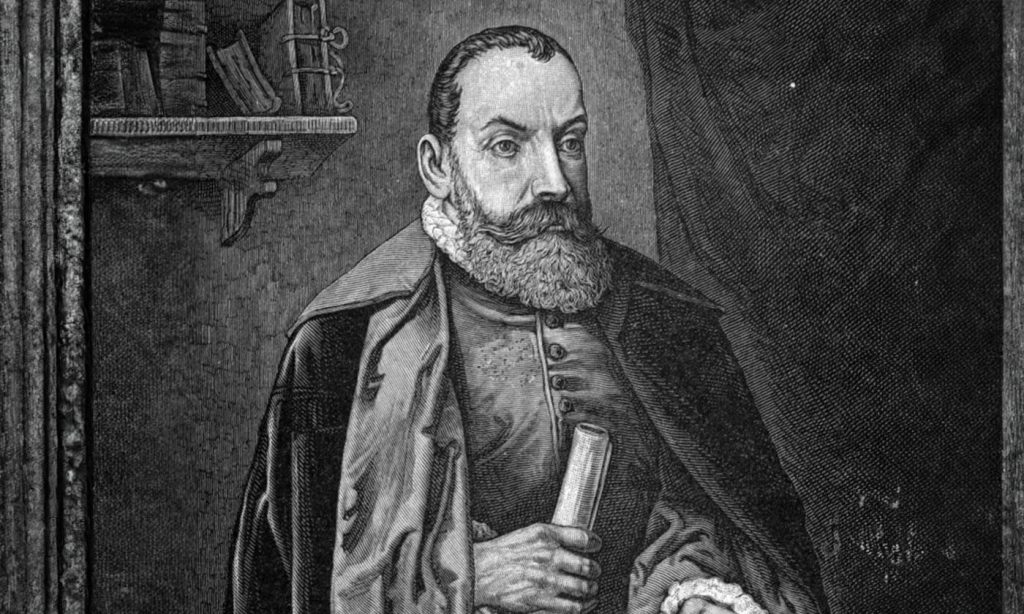Jan Kochanowski was a great Polish poet. He was born in Sycyna, a small village in Poland. He studied at the University of Königsberg (East Prussia) and at Padua University (Italy). He then returned to Poland and served as the royal secretary to King Sigismund II Augustus, before settling on a country estate and marrying Dorota Podlodowska. He was an active humanist and Renaissance poet, writing several hundred compositions in Latin and Polish.
He died in 1584 and was buried in a church in Zwoleń along with other family members. In 1791, a historian removed a skull (presumably belonging to Jan Kochanowski) from this family tomb. This skull later became the property of Czartoryskis Museum in Krakow.
Does the skull really belong to Jan Kochanowski?
In 1926, an anthropological study of the skull questioned whether it really belonged to a male. The anthropologists instead thought that is was a female skull, and therefore could not be Jan Kochanowski’s. In 2011, scientists were finally able to use genetics to solve this long-standing dispute.
Is the skull from a male or female?
The first aim of the genetic analysis was to determine if the skull belonged to a male or female. DNA was extracted from a single tooth removed from the famous skull and two different gender-specific regions of the amelogenin gene were analyzed. Both regions (intron 1 and exon 2/intron 2) indicated that two X chromosomes were present, thus identifying the female sex of the skull. This female gender was confirmed by the absence of a genetic signal for 17 male-specific Y chromosome markers.
Mitochondrial analysis of the skull
Determining the mitochondrial DNA (mtDNA) profile of skeletal remains is a useful approach for identification purposes. It can indicate which region of the world the individual is likely to be from, and provide answers about maternal lineages, as it is inherited in a strict maternal pattern (mother to child) and has a rapid rate of evolution. The analysis of mitochondrial DNA (mtDNA) in ancient remains is often more successful than nuclear DNA, due to the high number of the mitochondrial genomes (hundreds) in each cell, compared to only two copies of the nuclear DNA per cell. The two hypervariable regions of mtDNA often provide the most variation and information for the analysis of ancient remains. Both these regions were sequenced from the tooth samples and identified a relatively frequent mtDNA profile among contemporary Europeans.
Determining the eye color
It is now possible to use genetic analyses to determine specific traits, such as eye color, for unknown remains. The geneticists in this study were able to use genetics to determine that the unknown woman (whom this skull was from) most likely had dark eyes.
Conclusions
This study has confirmed the anthropologists’ predictions that the skull belonged to a female, so it cannot be Jan Kochanowski’s skull. Although it is unconfirmed, it has been speculated that the skull actually belongs to Jan Kochanowski’s wife, Dorota. His wife was around 50 years at her death (the same age as that predicted for the skull), she had dark eyes (as predicted by genetic analysis of the skull) and she was buried in the same tomb as Jan. It is possible that the historian in 1791 actually retrieved the skull of Dorota, rather than Jan. Future identification of the skull may be possible if maternal descendants of Dorota can be identified and their mtDNA profiles compared to that obtained from this unknown skull.

DNA Database Comparisons
The DNA tests conducted in this study have defined the putative mtDNA profile of Dorota Kochanowski (née Podlodowska). If you have taken the mtDNA HVR1 and HVR2 (Advanced Maternal Ancestry) test, you can compare your mtDNA against Dorota to see if you may have descended from the same maternal lineage as this Polish woman.
DNA Ancestry Project Features
Ancestry Test
Mitochondrial DNA sequencing
Y-DNA STR fragment analysis
Autosomal STR fragment analysis
Advanced ethnic origins report
Recent ancestry analysis
Ancient ancestry analysis
DNA Ancestry Projects
Relationship match
Relationship confirmation









